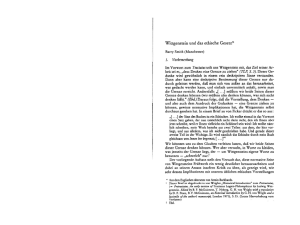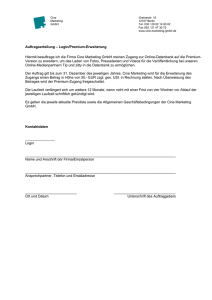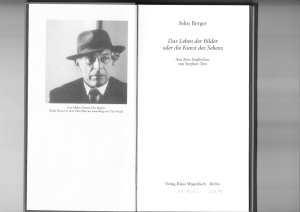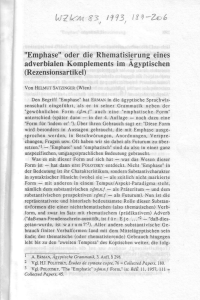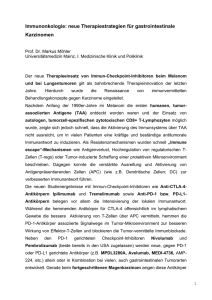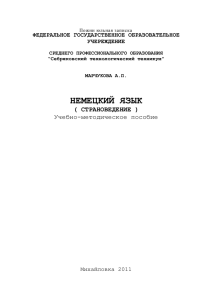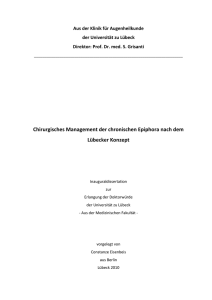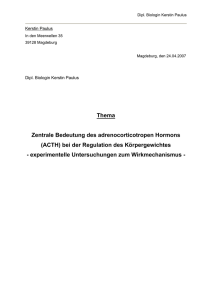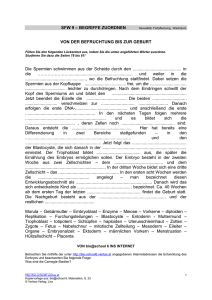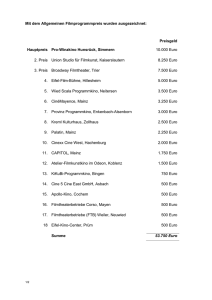Fisheries Research Board of Canada Translation series No. 886
Werbung
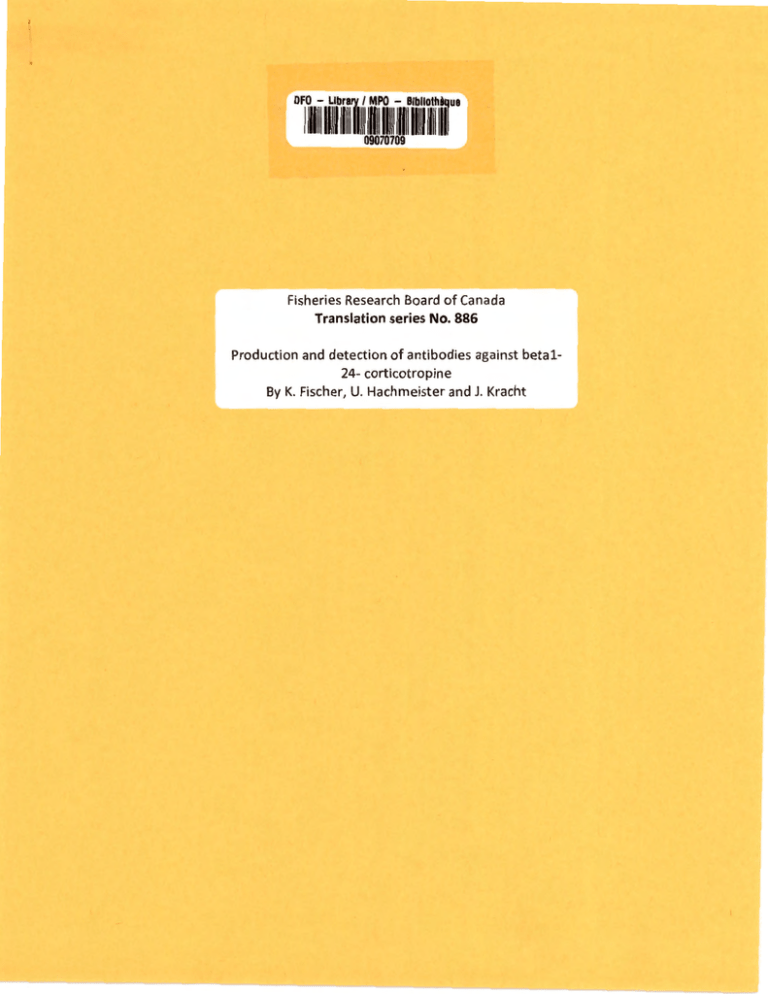
Fisheries Research Board of Canada
Translation series No. 886
Production and detection of antibodies aga inst betal24- corticotropine
By K. Fischer, U. Hachmeister and J. Kracht
..
.
------~--·-
-·~·
-
...
.. ·-··'1.'6
•.
1f/o
ff(o
.> .. ,cAU FOR TRANSLATIONS
SECRETARIAT D'ETAT
BUREAU DES TRADUCTIONS
~=.:>REIGN lANGUAGES
DIVISION DES lANGLES
DEPART•·'
~T OF HIE SECRETARY OF STATE
ETRANGERES
DIVISION
TRANilLATII!D P'ROM- TRADUCTION DB
INTO-
German
English
I.
SUBJECT- SUJET
!.
Imr::unology
I .
.AUTHOR - AUTEUR
K. Fi~cher, U. Ha·a~eister and J. Kracht
TITLE IN ENGLISii- TITRE ANOLAIS
Production and Detection of Antchbodies againRt fl-24-corticotropine
TITLE IN FOREIGN LANGUAGE- TITRE EN LANOUE EfTRANOi!RE
Darstellung und Nachweis von AntikBrpern gegen
pt- 24-corticotropin
REFERENCE- RilFitRENCE (NAME OF BOOK OR PUBLICATION- NOM DU LIVRE OU PUBLICATIONI
Naturwissenschaften, Vol. 52.
PUBLISHER- lfDITEUR
?
I
CITY- VILLE
DATE
1965
Dr. E .M. Donald son
I.....
.
347-348
8153-1
,lEQlJEST
RECEIVED
F<ii:Qu(S
PAR
_ _ _FRoM
_ __;__ _ _ _ _ _ _ ___:__ _ _ _ _ _ _ _ __
OUR NUMBER
NOTRE DOSSIER NO_;:_;:.~:..._:~--
O;'r>ARTMENT
TRANSLATOR
TRADUC TllUR _
,..m.;STERE
Fisheries
7
(
Fi sherie P Research Board )
Vancouver, B.C.
18 14
YOUR
NUMBER
~ l"l _ _
VOTREDOSSI~RNO_____
O_P_- ____________________________
il
7
19 ________________________
OATE RECEIVED
RH~ULE _ _ _ _ _ _ _..;..A~p~r------~'----6.;...7
__..P...sJOI-'.u.V_ _ _ __
DATE COMPLETED
IUiMPLIII Lll _ _
. ;.1.;.; 1.; . •.;. .0_-..;. •_6_7_ __
··----·--
-------~----------------,.._
____________
.
DEPARTMENT OF THE SECRETARY OF STATE
SECRETARIAT D'ETAT
TRANSLATION BUREAU
BUREAU DES TRADUCTIONS
FOREIGN LANGUAGES DIVISION
DIVISION DES LANGUES ETRANGERES
YOUR NO,
DEPARTMENT
Dl VISION/ BRANCH
CITY
VOTRE N°
MINISTERE
Dl VISION/DIRECTION
VILLE
769-18-14
Fisheries
OUR NO,
NOTRE NO
Fisheries Reseurch
Boarcl
LANGUAGE
TRANSLATOR (INITIALS)
LANGUE
TRADI,ICTEUR (INITIALES)
DATE
PJW
German
8153-1
Vancmuver, B.C.
9.5.G7
I
I
i
TrenRlation of article published in "Naturwissenschaften",
Vol. 52, i<.ro~, pa~f' s 347-348.
Ij
l
i!
j
1
!
l
'
l
PHODUCTION J-11TD DETECTION OF JJ-JTIBODIE9
AG,~INST
p1 - 24-COH'ri COTRQPINE
(Darstellung und Nachweis von
Antik~rpern
gegen
24-Corticotropin)
&-j
l
By K. Fischer, U. Hachrneister und J. Kracht
j
Through the immunization of rabbits with synthetic,
biologically-active ~ 1 - 24 -corticotropine it was possible to
produce antibodies which apparently reacted specifically
with this ACTH-componenet part, as well as with the natural
ACTH of different animals.
To achieve the formation of such
antibodies, at least six i.m. injections had to be administered
at weakly intervals; altogether we applied a total amount
of 1.. 5 mg
~~- ~-:-o_orticotr?pine in Freu!ld' s ad .iuvunt s
2
l complet€1.
The presence of the antibody was proven with the hemagglutination test aooording to Boyden and the dirEct iromuno-
•
-
2 -
fluorescence test after labellin~ the antibody with fluorescein. thi ocyanate 2 ' 3 . Parallel experiments with extractive
1so
ACTH from u swine (acPthropan - Hoechst), which was used
24-corticotropine for ir:mmnization of the
alons~side the
p-
rubbits, as well as for the
loadin~
of the wether erythrocytes,
yielded the following findings: corresponding to the reports
.
4
by McGa·rry and co-workers , the reaction of anti-aoetllropan
with
erythrocytes cannot be inhibited by
acethropap~loaded
p- 24-corticotrop.ine,
\·
but it can be inhibited by acethropan.
An inhibition by these two corticotropic substances, however,
took place if.the teet-erythrocytes were loaded with
p1 - 24-
oorticotropine. On the other hand, the reaction of anti1-24
~
-oortiootropine can be inhibited by ao~thropan and
..
~l- 2 4-corticotropine, no matter whether the test-erythrocJtes
are loaded with acethropan or with ~- 24 -corticotropine.
According to this, the hypophyseal ACTH contains a mutual
'
1-04
.
antisenct.c , ·· component with the
-cotticotropine and at
F. 348
p "'
least a further antigen.
Invefltigations with the direct
irununofluorescence technique gave no indication that the
second antigen exists in a reaction-capable form in the
swine-hypophy~is
or in hypophyses of other species.
It is possible that
the preporation:
.~f
ACTH
thi~
whi,~~~.
antigen is formed only in
as is generally known, contains
a considerable amount of unspecific peptiden or proteins.
The antibody produaed by.the ir.l!Ilunize.tion with
~ 1 - 24 -aortiootropine reacted with the ACTR-forming cells
-
~5
-
of the hypophyses of the following species: man, dog, cat,
rat, and pigeon.
A po8itive reaction was alRo achieved
with rabbit-hypophyses, without the immunized snimals havin,o;
until then (maximu:n obsPrvation period 9 months) exhibited
signs of an
cortex.~
AC~I-deficiency,
i.e. an insufficiency of adrenal
A species-specificity of the antibody could not be
established •
.. -In
l
conclusion, it Rhould be especially point~d
out
.
94
.
.
that the ~1jJ
.... -cort1cotrop1.ne used for immunization VJas
•
1
biolo,3ically active, while Axelrod and co-workers were able
to achieve an antibody formation in the guinea pig with
a corticotropic peptide with 23 amino acids only after
blocking the cortiootropic effect.
The investic;ations were carried out in part with
the support of the German Research AsRociation.
Children's
,.. clinic: (Director: Frof. Dr. K.H. Schllfer)
and
Patholo~ical
Institute
~f
the University (Director:
Prof. Dr. Dr. h. c. C. Krauspe.) , Hamburg.
K. Fischer, U. Hachnwister and J. Kracht
•
Received on March 10, 1965.
AWe would like to thank Ciba 1 A.G., Basle, for letting
us have the ~ 1 - 24 -oorticotropine (Ciba 30920-Ba), und the
Farbwerken Hoechst A.G. for lettin~ us have acethropan.
'
lic·u
••• ,
1\:urzl' < lri~'inallnil tL'ihtl\t 1 Pll
12
h_____________h----------------------------------------
(.\''21-~':______________________________________________
Isnlicrun~ von i'·F.agarin nus l~uta gr.-~V(.:U11!11S
:'\";\ch ~~~ H•.~;. :..:;~ \\'l~r dcr t'ILI;~ocytll:::.L~·liHiex elwa ·ltnal :-;o lHwh
"ic lH.'l den 1\i.lllrulltil·lt'IL -·- _;h. Cuproxanl-l.ignin und
Hjur1,tn;,n-1.i;.,;l•in•) (;\US Fi\:h1l'llholz): hl'idc l'ri\paratl' waren
unwlrl,~.\Ul.
E11\ qu.~nt it.\t j,·,·r Y~..·r.L:Iei...:h dic~cr \"ersuchst'll~t·hnissc
Zl'igt, t!.\L 'n·.J,·r ~:~·r l;c:h.liL O\ll Ce\1\llose noch an l.i~nin die
·vr~nch~.· :\\r d;c l'h,,~,u:~·h.):,t·steigcrung Unrch ~l.L.-1\latter
:-:.ein kann. \·iclkid.t :-.lnd bc:-ttinunt~ l'o\ys~\ccharitlu unt\ U01·U ..
~tofk,
dit• in llolz unJ Bbt tern cnlh;tltcn scin ltiinncn 4 ), d;tf\ir
vera n l won Iic h.
Die ,·,·rs,chicdcnc pharmalwlohischc \Virks;tmkcit tlcr
Lig-nin-1 'riip•n·• tc ki\nntc auf verschicdenPn physikalischchetnisl'hcn und struktur-chcmischcn Eigcnschaftcn bcruhcn.
\'icllcidlt l·rgcbcn die vcrs(\tic<lcnartigcn Vcrf;thrcn dcr
Li:,:nin-Gcwinnung al>cr auch l'roduklc von vcrschicdcn hohcm
H.cinhcitsgrad. 13ci dcm Schol\er-Tornesch-Vcrfahrcn konntcn
bcrcits im :\usgangsmatcrial (Fichtcnholz) enthaltenc Wirkstoiie crhaltcn l:>icibcn, die bei den andcren Mcthodcn der
Ligningcwinnung al:>gclrcnnt wcrden. Da bei diescm Vcrfahren
hohc Tcmpcmlnrcn bci s;turcr Hcaktion angewandt werden,
konnle dcr phagocytoscslcigerndc Stoff aber auch erst bci
der Aufarbcitung des Holzes entstchcn. Bcide Moglichkeiten
stchcn im Einkl;tng mit der Angabe des Herstellers, dal3 im
Scholler-Tornesch-Lignin ( Porlisa11} gcringe Hestc von Polysacch;tric\en (Cellulose) sowie Spuren von Sulfaten enthalten
sein k6nnlcn.
Dcm Bundcsministerium fiir wisscnschaft_liehe Forschung
dankc ich fur die finanzicllc Unterstutzung det; Versuchc.
A btcilullg /iir Pharmakologie tmd Radiobiologic, Heiligmbtl'g-J Jlstit~<l, 11 ciligcJtbcrgf Badc11, 1111d Radiologisches I nstitut
dcr UHivcrsitat, Frciburg i. Br. (Direktor: Proj. Dr. Dr. H.LANGENDORFF)
l(URT FLEMMING
Eingcgangcn am 19. ;\iarz 1965
•) Herrn Dr. DtCARI.o, \VARNER-LAMn~;RT Research Institute,
:llorris Piains, danke ich liir die Oberlassung der Maytenus·Biatter,
llcrnt Tu. 1\n•JO/Frciburg L Br. fiir die Obermitllung von Schol\erTomcsch·Li;;nin Porlis(W (J'ercola,' Miinchen-Solln) und Herrn
Professor Dr. I<. FHEUDE:-<nERG, Heidelberg, fur Versuchsmcngen
von Cupcoxam· unci 13jorlonan-Ligin.
1 ) DICARLO, F. J., L. J. HAYNES, N.J. SILVER u. G. E. PIIILIPPS:
J. Reticuloendothelial Soc. 1, 224 (1964).- ') Fucns, W.: Die Chemic des Lignins. Berlin: Springer 1926.- ') Bwzz1, G. B., B. BENACERRAF, C. STIYFEL U. U. N, HALPERN: Com pt. rend. 148, 431
(1954). -- ')BRAuNs, F. E., u. D.A. BRAUNS: The Chemistry of
Lignin. New York u. London: Academic Press 1960.
Alkaloide aus Vallota purpurea
Die zur i\m;tryllidc;tc-Subtribus i\maryllidinae gehorencle
(;;~ttung Ya\\ot;t ist in Deutschland durch die in Europa kultiviertc Va\\ota purpurca vertrctcn. 13ei fri.ihercn Untersuchungen konnten ;tUS diescr Species bcrcits die Alkaloidc Lycorin 1).
l';~rk;~min 2 ), I-lippc;tstrin2), Hacm;tnth;tmin 1 ), Hacmantidin 1),
Galanthamin 1 ). Vallolin 1 ) und Val\otidin 1) isoliert werden. 1
\\'ir haben nunmehr erncut frischcs Pilanzcnmatcrial dicser I
Sortc ;ttdgcarbcilct untl konntcn dabei, ncben dC'n bcreits )
bckanntcn B;tscn Gal;tnthamin unci Haemanthamin, durch
fraktioniertc Kristallisation unci Saulenchromatographie cin
wei teres Alk;tloicl auffi11dcn, das mit kcinem dcr bishcr bckanntcn iclcntifiziert werdcn konnte und daher Vallopurfin genannt
werdcn sol\.
Va\lopurfin ist cine tcrtiare Nichtphenolbasc, die nach
wi.;clerholtem lJmloscn aus Aceton in feincn Prismen kristallisicrt unci bci 244-47° Zcrs. schmilzt. C18 H 23 0 6 N Ber.: C 64,85
li6,9S N4,01. Gcf.: C64,59; H6,92; N4,01. [ct]v: -90°
(c =0,2 Ath;tnol). Pikrat: fcinc N;tdcln aus Aceton; Schmp.:
193° (Zcrs.), Pikronolat: amorph. Schmp.: 360° (Zers.).
Die Base gibt mit konz. Mineralsaurcn keine Farbreaktion,
tlcr Test auf 1\lcthylcndioxy-Gruppcn ist positiv. Das IRSpektrum (KBr.) der I3;tse zcigt cine intensive Doppclbandc
bci 1 510 cm- 1 und r.wei wcitcre starke Band en bci 1620 und
940 cm- 1• Das UV-Spclttrum in Mcth;tnol zcigt ein intensives
;\l;tximum bci 292 nm. V,a\\opurfin ist in allen organischen
L6sungsmittcln nur maOig loslich, gut loslich jcdoch in.
Athanol.
II. Cllemisclles Institut der Humboldt-U11iversitat, Berlin
\VERNER D6PKE und GUDRUN FRITSCH
Eingegangcn am 29. Marz 1965
l3oiT, H. G.: Chern. Ber. 89, 1129 (1956).
u. W. D6PKE: Chern. De~. n, 2578 (1959),'
1)
1)
DolT, H. G.,
Furochinolin-1\lkaloide sind iu z;lil:r•·i,·}Jc·Jl
L.
(;;It\ tli•,..;l'll HI>~;
Arlen der l<utac<'l'll \'l'rl•rcitcl. In dl'r \\',·inralllc 'i"d Sl<ilnund J\oku~aginin ZIH'r~l. 1 'J)S n:t1 l1;...,:'c\\ it·:.. t'il \\"l.rdcn ',.
ln den ()rga1h'll dl'r \\\.:inrotulc Jnittel,·un,p:l;~,·lwr I i~.·rlu1nlt
fanlh·n \vir O,llflj--(I,UJn;, vonl Trncl\('fl~~c\\icht. SJ..:iJiln<i .. nin~,.
Als wcitcren ha~isclu:n lnllallsstofl l1rdwu \\'ir jt·t;.t l'in .\il..:alr,id
Jllian11\
isulic!'l, de"~il VorlWI1111l,'ll
llcschricbcn wun\e.
ill
1\l'l'
\\'l'inrillll'-' nw:h nicht
Ein salzsaurer Anszug des ).Ictllilllol-Extrai .. tc~ •1cr \\"urzcln wurdc nach dctn Alkaii:.;ierc·n n1it Soda er~(;h\·,;;lend aus-
ge;tthcrt. Die ;\u[trcnnung des l<uhall«tluidgemisch('s ,·rfolgtc
.tiber l\:icsclgckcu\en. Das !LtuplalkaloiJ wunlc meilri<tr.h hth
vcnllinntcm Atb;mol umkristallisierl. Es war chrumalugraphisch rein. Die Analyscnclalcn '\icscs ,\lk<tloids dc.:ckcn
sich wcitgehcnd mit dcncn Hir d;ts y-Fagarin (4,8-Dirnethuxvfuro-[2,3-b]-cbinolin), das crstmals ;tus Fagara coco (Gilf.)
Engl. isoliert wunlc 3).
·y-Fag;trin C13 ll 11 0 3?-\ (her.: C (,8,11; ll 4,84; ::\ G,t;;
OCH 3 27,08. Moi.-Gew. 229,23; gef.: C G7,tiG; H 5.12; ::\ !),22;
OCH 3 27,04. l\1ol-Gew. nach Hast 221i). Die aus Ac<:ton-Atbcr
umkrista\lisicrtc Subsl;tn7. schmilzt bei 141°. Dcr Schmclzput.l;t
des Pikratcs und Pikrolonatcs ist 176-1 i7° (Zcrs.) hz\\'. 1 ;.;
bis 175° (Zcrs.). Die Daten stchcn in gutcr ulJcrcinstimmung
mit der Litcratur 1 ). Dcr N-Gehalt des l'ikratcs betrug 12,23~ 0
(ber.: 12,22%). Das lR-Spcktrum dcckt sich mit den Angahcn
andercr Autorcn 5 ). Das UV -Spcklrum wcist in Docrcinstimmung mit den Litcraturwcrtcn .Maxim;t auf llci 244, 310 und
337 nm [log € = 4,83; 3,87 und 3. 79] 6 ). Allcrdings linden wir
ein weitcres Maximum bei 325 nm (log € = 3,84)- Die Umlagerung des Alkaloids mit Mcthyljodid in der Hitzc fubrtc
zum Iso-y-fagarin mit dcm Schmp. 179--180° 7 ). J'·Fagarin ist
auch in den obcrirdischcn Organcn dcr Pf\anze cnlh;tllcn.
Es ist als cin Hauptalkaloid dcr von uns untcrsuchtcn \\'cinraute zu bctrachtcn, die ;tus den Kulturcn des Heilpilanzcnbaucs dcr Chemise hen Fa.brik Promonta GmbH in \Villinghuscn
(Kreis Storm;trn) stammt.
Pllytoplzarma:reulisches Laboratorium der Chemischcn Fabrih
Promonta Gntbll, Hamburg
GEORG ScHNEIDER*)
Eingcgangen am 27. Marz 1965
Jetzige Anschrift: Phannakognoslisches Institut dcr Univcrsitiit, Frankfurt.
1 ) 0HTA, T., u. T. i\iiYAZAKl: Yalmgalm Zasshi 7 s, 533 ( 1953).
Ref. Chem. Abstr. 52, 3815;~ (1958).- ') Scn:-<EIDER, G.: Arzncimittel-Forsch. 14, 435 (1964).- 3 ) STUCKERT, G. V.: Invest. Labor.
Quim. Bioi. Univ. nac. Cordoba 1, 69 (1933). Ref. Chern. Zbl.
1934 I, 67.- ')BolT, H.· G.: Ergebnisse der Alkaloid-Chemie bis 1960,
S. 716. Berlin: Al<ademie-Verlag 1961.- ')BRIGGS, L.H., u. KC.
CAMBIE: Tetrahedron 2, 256 (1958).- ') lntAHTE, J., F. A. KtNcL,
'G.~RoSENKIMNZ u. F. SoNonEtMER: J. Chcm. Soc. 1956, 4170--•') DEULOFET4, V., R. LABRIOLA u, J. DE LANGIIE: J. Am. Chem.
Soc. 64, 2326 ( 1942).
0)
Darste\lung und Nachweis von Antikorpcrn
·,
gegen (31- 24 -Corticotropin
Dnrch Immunisierung von Kaninchcn mit tlcm synthctischen, biologisch aktivcn fi' 1- 24 -Corticotropin *) konnlcn Antikorper erzeugt werden, die sowohl mit dicscm ACTJ I-Teilstiick
als auch mit dem natiir\ichcn ACTII vcrschictlcncr Ticrc anscheinend spezifisch re;tgicrcn. Um die Bildung solchcr Antikorper zu crreichcn, muf3tcn mindestens 6 i.m.-Injcktioncn in
wochentlichcn Abstandcn vcrabreicht wcrdcn, wobci wir cine
Gcsamtmengc von 1,5 mg 1) 1- 24 -Corticotropin in Frcunclschcm
Adjuvans (komplctt) appliziertcn. Dcr Antikorpcrn;~chwcis ·
wurde mit dem 1-Him;tgglutinations-Tcst n;~ch BoYnE;.; und
dcm direkten Immunfluorcszcnztcst nach :\!;~rkicrung <!cs
Antikorpcrs mit FluoreszcinisothiocyanM 2), 3) crbracht. Paral\elvcrsuche mit extraktivem ACTH vom ~chwcin (Acc~hro­
pan-Hocchst), das ncbc.n dcm {1 1 -~ 4 -Corticotropin sowohl zur
Immunisicrnng dcr Kaninchcn als auch zur Bcbdung dcr
ll;tmmclcrythror.ylcn llcnutzt wurc\e, crgahcn folgcn<lc llcfundc: Entsprcchcntl den i\ngahcn von :'llcGAHln' u. :O.Iit;uh.')
liillt sich die Hcaktion von Anli-t\ccthropan mit acethn>panbcladencn Erythrozytcn durch fji-2 4 -Corticotrupin nicht hcmmen, wohl abcr durch Accthropan. Einc 1lcmmung durch
diese heiden corticotropcn Steffe cdolgte jcdoch, wcnn· die
Tcst-Erythrozyten mit {1 1- 24-Corticotropin be!adcn wurtlcn.
Andererscits lal3t sich die Rcaklion von Anti-(i'-~ 4 -Corticotro­
pin durch Acethropan und tJ1-24.(orticotropin hcmmcn, ganz
glcich, ob die Tcst-Erythrozyten mit Accthropan odcr {jl-24.
Corticotropin beladen werdcn .. Da.nach enthalt das hypophy_-
~
I
.\t'T::
ciiH' gcnH·in~i\1\H' ;tnt igl'IH'
1\olnpont·nle 1uil dl'll\
nnd JiliJH\c~tc..·ns t•in Wl'Ht·rt·s ,\ntig<'lL
\ ·nt,·r:-.til.:hull;.:c:tl 111it tkr direkl1..'1\ liHll\UilfhJon·szenztt·chnik
L-rg.dH.'Il l.;cincn .\niJ,til d.iLh, dai.\ das z\n·ill' .\nlig\'11 in rc ...
akti,)nsf.dlig-..·l- 1:,H_·n1 in dcr ~L·lnn·iiH'h~·puph~·sc b;r.w. in llypo·
s.irl'
;,,,. :\.Llnr·
1\ ~arze ( higina.hnit LL·ilungl'll
3-IS
!1 1 • :.!.a.c,•rti,·,,lrninn
phy:'cn .dld~...·rcr ~11l't'll':-; Yorh.ltHien ist.
:-,[ii.c:licn<'r\\'ci,,• l'l\bl<·ht dieses .\ntigcn erst l>ci dcr l'r:i.p.n.lti<>n Y<>ll ACT!!, d;~s l>ekannliich cine hetrilchllichc l\Icnge
unspczif:~~-·h . .·r l\'lltilil' <a1er llrotcinc cnlh~ilt.
I )cr d ;;rch 1 mmu ni,ierung mit ;;•- "'-Corticotropin crzcugtc
.\ntil;i··q•cr rca,c:iNle mit den :\CTIJ-bildcndcn Zcllcn dcr
llypnpl"·s<·n fu:gcnder Species: ;\lcnsch, Hund, 1\:atze, Hatt.e
und Taube·. ,\uch mit h:anin'chcnhypophyscn wurdc cine
jlositi\'e l{caktion crziC'lt, ohne daLl die immunisicrtcn Ticrc
hishcr (lkobachtungszeit max. 9 :\lonatc) Zcichen cint:>s
.\CT!l-:-.Iangels, d. h. Kebcnniercnrincleninsuffizicnz, aufwicsen. Eine ,\rtspczifitiit des Antikorpcrs JicO sich nicht
fcststcllcn.
Abschlicl1cnd sci besonders damuf hingcwicscn, ciaO das
zur lmmunisicrung benutztc p1-24.(orticotropin biologisch
akti\· war, wahrcnd AXELROD u. l\litarb.l) mit cinem corticotropcn l'c;1tid mit 23 .\ minosaurcn cincAntikorpcrbildung bcim
::'l!ccrschwcinchcn erst nach Blockicrung dcr corticotropen \Virkung errcichen konnten.
Die l.intersuchungen wurden tcilweise mit Unterstiitzung
dcr Dcutschen Forschungsgemeinschaft durchgefiihrt.
Hiudcrldiuik (Dircktor: Prof. Dr. K. H. SCHAFER) und
Patholoj;isches Iu.<titut der Uniuersitat (Direktor: Prof. Dr. Dr.
II. c. C. KRAUSPE), lia111burg
K. FISCHER, U. HAcHiiEIST,ER unci
Eingr;;angcn am 10. ;\larz 1965
J.
l{RACHT
'
•) Der Ciba A.G., Basel, danl<en wir fiir die Oberlassung von
/!'-"-Corticotropin (Ciba 'J0920-13a), den Farbwerl<cn Hoechst A.G.
fiir die ubcrlassung von Acethropan. \
1 ) ,\xELRoo, A. E., A. C. TRAKATELr.rs u. I<. HoFMANN: Nature
197, 146-148 (1963). ')FISCHER, l<., ]. KRACHT U. U. HACH·
MEISTER: 2. Arbcitstag. ftir padiatrischc Forschung, Marburg 1965.1) HACH>~EISTER, U., u. J. KRACHT: Virchow's Arch. pat!Jol. Anat.
u. Physiol. 1965 (im Druck). - ') ~lcGARRY, E. E., L. AMBE,·
R. NAYAK, K. BIRCH 11. ].C. BECK: ;\letabolism 13, 1154 {1964).
On the Distribution of RNA in the Early Stages of the Development of the
Epithelium of the Inner Ear of Chick Embryos
BE;.;on 1",d) showed that a. good percentage of the otic
mesenchyme of chick embryos on the fifth day of development
when cultivated in uitro is capable of differentiating into precartilaginous tissue.
'·'·' i ~ _,.!I
'
I,_,':'
l!~t~ <p;;tnliLIIJ\'C ;,~·tiun <,I CL di[;·.ii•y tlH· ('jlii;H.;llilHhl.
ul ''Ur C\':iH lwn,,,·,J) :c·:~c·;,rr i. 11:1 ~ld·
iion could ht· cotlsid,·n·d ;ls
sil•lt•
sult~t;u11·c prod11l~cd
lh1ring- 1he Cour:,l'
hull or the inner {'ar OLt \'Otric•us 1"-li:\ts CJ( 1:1'\'(')l!illli{'Jil \\'(_' L;n·(·
observed a char;H.:tt•ri~t ir asp{'cl of t i a<: 1\ ':\. ,\ di:. . t ri l,t,; ic Ill in ~ lH:
first 111o1ncnts of the devclopJncnt ol t~1is ur~.111, \Vl1icli. \Ve
n·porll'd here.
Jfrtlwd aut! results. ;\s :-;oon as n;1novcd t:lc chic!\. cn1hr\·us
Aitcr inllK'{!<!ing in p.J.r;dfin,
the sections were treated according to HRACII "T's i,;Jicali<ll.s
\Vcre fixed in Carnoy :-;olution.
for the detection of J{;o.; A").
The results mily be Sllll\mctl lljl as foll<,ws:
a) in otocysl.s of embryos of two, three anrl four days of
dcvclopn1cnt a. characteristic scgrcg;ttion of J\ ':\A was tu be
noted in the cytoplasm of the cells oi the basal str;ct•lm of the
epithelium of the l>utl in immediate contact with the surrounding mesenchyme (Fig. 1a. IJ).
b) The picture described above i~ allenuated in the iivc,
six and seven clay embryo buds in which the \J;,sai accumul;..tion
only remains in certain tracts of the cpithc:ium.
Conc/u$ions. \Vc have felt that it was useful to point out
this characteristic accumulation of H~A in the otocyst,;
immediately before and in the moment of development clu~inr;
which, as shown by BENOIT 1 c), the induction action of the
otocyst is exerted on the competent mesenchyme for the genesis of the otic cartilage.
Hes<'arch in course tends to clarify this Rl:\A turnover
which may be involved in the inductor mechanisms mentioned
before.
Istituto di Biologia gcucra/e c Gcuc/ica, Univasilc< di .Va,ooli,
Caitedra di Istologia ed Embriologia, Uniuersi/a di Camcriuo *)
M. DE VmcENTIIS and F. :\lAJU!O
Eingegangen am 1. 1\larz 1965
•) Group of Research in Embryology of the C.;\, R.
BENOIT, ].A.A.: Compt. rend. a) 248, 1705 (1959);- b) 253,
2257 (1961); c) 258, 334 (1964); - d) J. Embryo] Ex'ptl. ;\[orj1hol.
B, 33 (1960).- 2) 13RAC11ET, J.: Quart. j. ;\licroscop. Sci. 94, 1 (1953).
1)
Elektronenmikroskopische Untersuchungen an den cpitheloidcn
Zellen dcr Hoyer-Grosserschen Organe
An lebcndfrisch fixicrtem Material [Fingerbecrenbiopsic 1). 2 )
bei cincm kreisla.ufgcsundcn 22jiihrigen :\lann unci 9 an Arthritis rhcumatoidcs leidendcn Paticntcn] wurdcn die cpithcloidcn
·, : ,: < ~l
~\:r:Y~:~:I:;:T~:~:.;~
•
·.
. ~.. ::: ~. ,:.
-:..,
. ~ ..
·.
..,.
;·. ~-
•
I
,,•
I
...
...
' .,
.1,':_
~~
. . ·,,- ~
•• • •
I
·-···
·:
'
·, • ' .
·~:·
-
. ,.•
.
·v~
fl
J
•
_.·._:}.
;: ~4~
·. ·:.:· :....~~~·'""" :. ·<-~--~-.:.~ ·,_. i
.; ~ .'.,!·: . . .· " ~ .- .'J,1
·!
,.:. ~... i
'
••
. ';'• •.:... /.!;
I
r· - ----- ,_- \ . :· ~ .- ?<]:~h'.\
Fig. 1 a and b. a Chick embryos of 53 h of incubation. Blue toluidin 2% coloration. On inspection the accumulation of RNA in the
cytoplasm of the cells at the base of the othocyst was noticed (X 92).b The details of Fig. 1 a (X 921)
The same mesenchyme, on the contrary, taken from embryos on the second day of development docs not show this
capacity. The epithelium of the inner car, furthermore, has the
power of inducing the formation of cartilage from the competent
mesenchyme up till the 8th day of dcvclopmcnt 1b). This
capacity is also common to the extract of otocysts; the indue-
~J~j~~~?,{~tt~'~k~Jf17ti
..._.~-
:•
.•:. .. ; ___, / ... ··' .
~-
~
~*::;i~~;Jt~r:c-~
'1
- -::L"J
Fig. 1. Querschnitt durch das intcrmcdiiire S(·,;mcnt cines HoynGrosserschcn Organcs aus der ~littcliingcrbccre cines krcblauigesundcn 22jiihrigen !\[annes. Die linl;c llildkantc ist <km Lumen
zugekchrt. E Keme cpithcloidcr Zellcn. Ver;:roOcrung 22 500: 1
(auf die Halite verklcincrt)
.c~;
